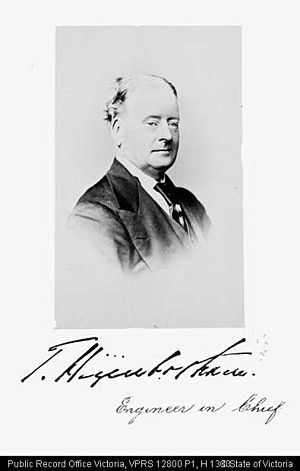Thomas Higinbotham facts for kids
Quick facts for kids
Thomas Higinbotham
|
|
|---|---|

PORTRAIT OF T HIGINBOTHAM, Engineer in Chief
|
|
| Born | 1819 |
| Died | 5 September 1880 (aged 61) St. Kilda Street, West Brighton, Victoria
|
| Nationality | English |
| Education | Castle Dawson School and Royal Dublin Society House |
| Occupation | Engineer |
| Parent(s) | Henry Higinbotham, Sarah (née Wilson) |
| Engineering career | |
| Discipline | civil engineer |
| Projects | Bendigo railway line, Outer Circle railway line, Victoria |
Thomas Higinbotham (born 1819, died 1880) was a talented engineer from Ireland. He was a very important person in building railways in both England and Australia. He helped design and build many train lines that are still used today.
Contents
Early Life and Learning
Thomas Higinbotham was born in Dublin, Ireland, in 1819. He was one of several sons to Henry and Sarah Higinbotham. He went to school in Dublin at Castle Dawson School and also studied at the Royal Dublin Society House.
Becoming an Engineer
Around 1839, Thomas moved to London, England. He started working for companies that helped plan new railway lines. He often spoke to important groups about these projects.
He then became an engineer for British railways. He worked with a famous engineer named Sir William Cubitt. Sir William Cubitt helped many young engineers learn about building railways. Thomas learned a lot from him.
Thomas worked on different railway lines in England. He was an assistant engineer for the South Eastern Railway. Later, he became a resident engineer for the Great Northern Railway. This meant he was in charge of building a section of that railway line. In 1854, he became a member of the Institution of Civil Engineers. This is a group for professional engineers.
Moving to Australia
In 1857, Thomas Higinbotham moved to Melbourne, Australia. He lived with his older brother, George, who was also a well-known person in Melbourne. Thomas never married.
Building Railways in Victoria
Soon after arriving in Australia, Thomas got an important job. He became the Chief Engineer of Roads and Bridges for the colony of Victoria. This meant he was in charge of building all the main roads and bridges.
In 1860, he became the chief engineer for the Victorian Railways. This was a very big job! He took over from the first chief engineer, George Christian Darbyshire. Thomas was responsible for planning and building all the new railway lines in Victoria.
His first big projects were lines to Ballarat and Echuca, which went through Bendigo. He also worked on many improvements for the railways. These included:
- Deciding where train stations should be built in Melbourne.
- Building Melbourne's Outer Circle Railway.
- Making sure trains could travel smoothly between Sydney and Melbourne.
- Making sure all railways in Victoria used the same track width, called a "standard gauge." This was five feet and three inches wide. This made it easier for trains to travel everywhere.
Challenges and Return
In 1878, Thomas Higinbotham, along with other senior government workers, lost his job. This happened because of a change in the government. A new engineer named Robert Watson took his place.
Over the next two years, other Australian states and New Zealand asked Thomas for his advice. He traveled to South Australia, Tasmania, and New Zealand to help them with their railway systems.
Final Years and Legacy
In March 1880, the government in Victoria changed again. Thomas Higinbotham was asked to return as the chief engineer of the Victorian Railways. However, the government soon changed once more, and Thomas was not happy with the new leaders.
He decided he would resign from his job. But before he could, he sadly died in his sleep on September 5, 1880. William Elsdon took over his role as chief engineer.
Thomas Higinbotham was a highly respected engineer. He played a huge part in building the railway network that helped Victoria grow and connect its towns and cities.


